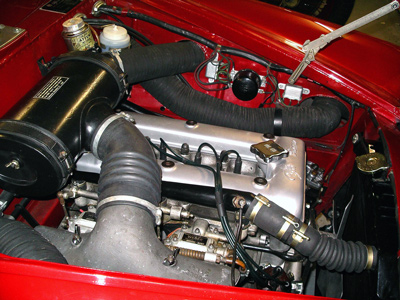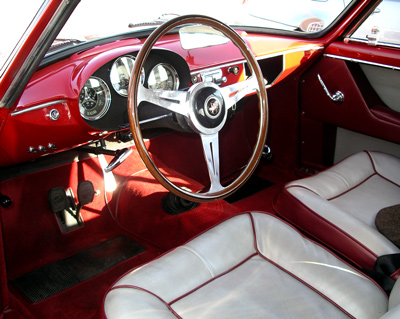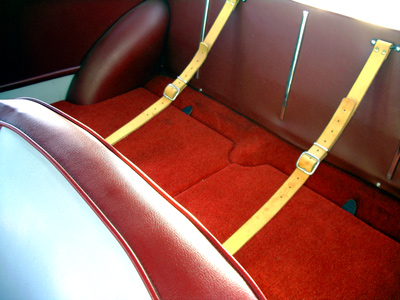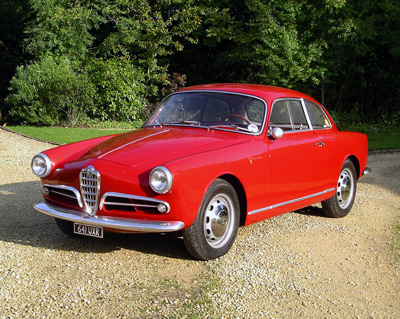Shortly after the introduction of the totally new Alfa Romeo Giulietta Sprint in 1954,
the directors at Portello took the decision to develop the Sprint as a competition car. It was certainly a good place to start. The basic Giulietta Sprint had been designed by the same technicians responsible for the racing program, and it showed. For the mid-50’s the Giulietta was technically advanced, with a high-revving twin camshaft engine constructed out of aluminum alloy and the gearbox and differential casing made from the same material. The suspension was conventional but well thought out: independent at the front with unequal-length A-arms, coil springs and an anti-roll bar; at the rear there was a well located live axle with single lower trailing arms and coil springs, while a tubular A-bracket linked the top of the axle casing with the floor pan, ensuring excellent location. The brakes—large finned drums—were excellent for that period, while the fact that the Sprint looked terrific didn’t hurt either.
Although the Sprint wasn’t originally conceived as a racing car, its advanced specification and fine performance had persuaded many Italian drivers that it would be well suited to the 1300 cc class in GT racing, which was growing rapidly in popularity at that time. In national events both standard and modified Sprints had enjoyed some success but at the international level the limitations of the standard Sprint were soon exposed, most often by the arch enemy, Porsche.
In the spring of 1955 several Sprints appeared for the 22nd running of the Mille Miglia, but all were forced to give best to the Porsche team, which stormed to victory in the 1300 GT class, leaving the first of the Sprints trailing home in third place. So the target was obvious; all Alfa Romeo had to do was hit the bulls eye.
Development
Engine development was in the capable hands of Giuseppe Busso and his department and their work is obvious as soon as you lift the bonnet. Behind the grille an intake nozzle—used for cockpit ventilation on the Sprint ‘normale’—was modified to duct air through a large diameter flexible tube to a cast aluminum collector box on the intake side of the engine, via an air filter mounted on the firewall.

This immaculate and correct Sprint Veloce is owned by the photographer, Paul Gregory. Note the unusual air intake system feeding the dual Webers.
|
This was a development of a similar system, used on the final version of the ‘Alfetta’ grand prix car, and credited with boosting the 159's output by 25 bhp.
A Bendix electrically driven fuel pump replaced the engine-driven mechanical unit of the standard Sprint, supplying a pair of Weber 40DCO3 side draught carburettors. The cylinder head ports were cleaned and polished, while the compression ratio was raised from 8.0:1 to 9.1:1. High lift camshafts were part of the package and the conrods were shot peened. A new tubular exhaust manifold coped with the increased gas flow while down below, an elaborately baffled cast aluminum sump, with built-in oil cooler, replaced the standard Sprint's steel pressing. Assembled with tremendous care and attention to detail, the modifications resulted in the overall output being raised from 65 to 90 bhp (DIN) at 6000 rpm, with torque improving to 86.5 ft-lbs at 4500 rpm, up from 79.5 at 4000 rpm.

The Sprint Veloces, particularly the early 750 series cars such as this one, used a variety of ways to save weight; note the missing glove box lid.
|
The modified engine was fuelled from a tank increased in size from 53 to 80 litres, a decided benefit for endurance racing, while a stronger clutch mated with a modified gearbox that placed the gear lever on the floor, rather than on the steering column. The final drive ratio was raised from 9:41 to 10:41 providing 18.6 mph per 1000 rpm compared to the standard Sprint's 15.7 at the same revs in top gear.
Placing the gear lever on the floor was welcomed by most critics, although not everyone seems to have been happy about the change. Gregor Grant road-tested a standard Sprint for “Autosport” in 1955, and the column gearshift was his main criticism in an otherwise enthusiastic review—yet a year later, in his report on the 1956 Mille Miglia, he recounts how Sprint Veloce drivers considered the revised method of changing gear slower than the standard Sprint’s “waggle stick” on the steering column!
In addition to these wide-ranging mechanical improvements, the first 600 Sprint Veloces were extensively lightened. The steel bonnet, boot lid and doors were all replaced by aluminum, as were the bumpers. The rear screen and the side windows were replaced by perspex, while sliding side windows eliminated the weightier roll-up mechanisms of the standard Sprint. Inside, the replacement side windows also freed up more elbow room for the driver and passenger, and lightweight competition style seats provided them with greater lateral support.
There has been some debate over the amount of weight actually saved by this process. Suffice to say that both Anselmi and Alfieri quote the following: the standard 750B series Sprint came in at 850 kg while the 750E Sprint Veloce weighed in at 780, a worthwhile saving of 70 kgs. Interestingly, the later 101 series Sprint weighed in at 880 kg, while the 101.5 Sprint Veloce—now equipped with the standard steel body, and the same specification windows and bumpers as the Sprint ‘normale’—came in at 895 kg, a slight increase, presumably reflecting the greater weight of the modified engine and it’s ancillaries.

Later cars also had small seats molded into the tiny space behind the front seats. The space worked better as luggage room.
|
Externally there was very little difference to the appearance, the main give-away being the sliding side windows on the Sprint Veloce, while the new model carried the script “Giulietta Sprint Veloce” along the front wings, along with the Bertone motif which honored the constructor of the Sprint bodies.
The new model proved popular from the start, both for track use and as an uncompromising road car. This was despite a sizeable increase in price over that of the Sprint ‘normale’. While the Sprint was offered at 1,735,000 lire, the Sprint Veloce commanded 2,050,000, a healthy premium. Most buyers probably reckoned this to be quite reasonable considering the amount of work that had been carried out and the extra performance. The sales figures seem to bear this out. First going on sale in April 1956, just in time for the Mille Miglia, 252 Sprint Veloces found buyers that year, whilst a further 458 were produced in 1957.
On The Road
“Auto Italiana” tested a Sprint Veloce over 4200 kilometres in early 1957. They considered the Sprint Veloce “so different to the standard Sprint that it might almost have been another car altogether”. Recording a standing kilometre time of 31 4/10 seconds, they concluded that the Sprint Veloce was “an almost unbeatable car.... and this is demonstrated by the number of victories it has scored on the track.”

The 750 series body with the smaller headlights, grille and taillights, was cleaner, more delicate and simply more satisfying than that of the 101 cars.
|
In February 1957, Jesse Alexander tested a privately owned example for “Sports Car Illustrated” (now Car and Driver). Better known nowadays for his fine motor sports photography, Alexander was the European correspondent for the magazine, and had taken to the Continental scene like a duck to water. He got the point of the Sprint Veloce at once, pointing out that “whilst the Sprint is a fine, high speed, touring-sports car.... the Sprint Veloce is considerably more than this. The car was literally born in the mountains of Italy—on the Radicofani, the Futa and the Raticosa mountain passes which make up the most rugged part of the Mille Miglia." He concluded: “ ....here is a true Italian competition machine with just enough comfort and flexibility left in the design to make it a really outstanding piece of equipment.”
Read Part II.
This article originally appeared in UK Alfa Romeo Owners Club Magazine. Our thanks to the club, owner Paul Gregory and especially Nicholas Lancaster.



